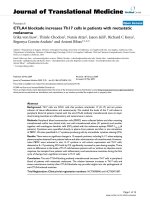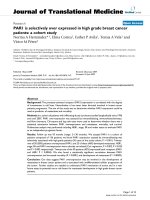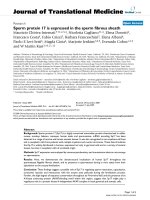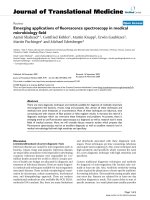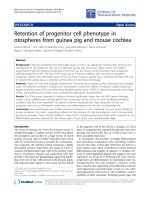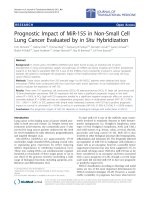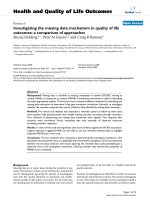Báo cáo hóa học: " Visual error augmentation enhances learning in three dimensions" docx
Bạn đang xem bản rút gọn của tài liệu. Xem và tải ngay bản đầy đủ của tài liệu tại đây (645 KB, 6 trang )
RESEARC H Open Access
Visual error augmentation enhances learning in
three dimensions
Ian Sharp
1,2
, Felix Huang
2
and James Patton
1,2*
Abstract
Because recent preliminary evidence points to the use of Error augmentation (EA) for motor learning
enhancements, we visually enhanced deviations from a straight line path while subjects practiced a sensorimotor
reversal task, similar to laparoscopic surgery. Our study asked 10 healthy subjects in two groups to perform
targeted reaching in a simulated virtual reality environment, where the transformation of the hand position matrix
was a complete reversal–rotated 180 degrees about an arbitrary axis (hence 2 of the 3 coordinates are reversed).
Our data showed that after 500 practice trials, error-augmented-trained subjects reached the desired targets more
quickly and with lower error (differe nces of 0.4 seconds and 0.5 cm Maximum Perpendicular Trajectory deviation)
when compared to the control group. Furthermore, the manner in which subjects practiced was influenced by the
error augmentation, resulting in more continuous motions for this group and smaller errors. Even with the extreme
sensory discordance of a reversal, these data further support that distorted reality can promote more complete
adaptation/learning when compared to regular training. Lastly, upon removing the flip all subjects quickly returned
to baseline rapidly within 6 trials.
Background
Since the beginning of tool use, humans have been chal-
lenged with operating external devices that do not neces-
sarily match natural limb movement. For example,
through repetitive practice a novice computer user has to
learn the remapping of anterior mouse motion to vertical
cursor motion on the screen. Such repetitive experiences
result in the learning of a neural representation that pre-
dicts the consequences of motor actions. Improving the
efficiency of this learning process has been a remarkable
area of research in neural engineering [1].
Recent studies have demonstrated error augmentation
(EA) during repetitive practice can lead to faster and
more complete learning for both visual [2] and haptic
[3] augmentation. However, this research evaluated EA
in small environmental distortions, typically a rotation
of the visual field of 30 to 60 degrees. Yet distortions in
everyday life commonly feature larger and often non-
linear distortions, or even complete reversals. For exam-
ple, this is the case when surgeons perform laparoscopic
surgery. Laparoscopic surgery requires the surgeon to
learn that moving the handle of the instrument causes
the tool tip to move in the opposite direction at a scaled
distance and altered mechanical advantage, known as
the fulcrum effect.
On the other hand, EA does not always cause more
effective learning. Studies have shown that the process
may not be effective for large errors [2]. Large errors are
relevant in this study, because in a flip paradigm there
are large errors initially, without the addition of EA. We
wanted to know whether the presented feedback, under
a paradigm where errors are large, would still continue
to inform the remapping process. If not, remapping
hence may be limited to the scale of the distortion [2].
It remains to be seen whether the augmentation learn-
ing process loses its effectiveness in tasks that involve
large distortions. At t he same time, the benefits of aug-
menting error may have the greatest impact on tasks
that require large distortions, such as laparoscopy where
large discrepancies in motor mappings occur.
In this study, we addressed larger distortions in which
subjects learned a full reversal. We evaluated whether
the learning process could be enhanced using error aug-
mentation. The results of our study suggest that error
augmentation assisted learning lead to improved perfor-
mance by the end of training, even in large distortions.
* Correspondence:
1
Department of Bioengineering, University of Illinois at Chicago, 218 SEO,
MC 063, 851 South Morgan Street, Chicago, Illinois 60607-7052, USA
Full list of author information is available at the end of the article
Sharp et al. Journal of NeuroEngineering and Rehabilitation 2011, 8:52
/>JNER
JOURNAL OF NEUROENGINEERING
AND REHABILITATION
© 2011 Sharp et al; licensee BioMed Central Ltd. This is an Open Access article distributed under the terms of the Creative Commons
Attribution License (http://creativecommo ns.or g/licenses/by/2.0), which permits unrestricted use, distribution, and reproduction in
any medium, provided the origina l work is properly cited.
Methods
This experiment utilized a three-dimensional, large-
workspace haptics/graphics system called the Virtual
Reality and Robotic Optical Operations Machine
(VRROOM). VRROOM is an integrated system com-
bining display environment, robotic forces, and track-
ing of limb movement (Figure 1). VRROOM’svisual
display system, the Personal Augmented Reality
Immersive System (PARIS), was developed in the Elec-
tronic Visualization Lab at the University of Illinois at
Chicago. PARIS is cur rently the highest quality system
available, with a high-fidelity PHANToM 3.0 haptics
device, Flock of Birds magnetic tracking devices, and
its 2000-lumen cinema-qu ality digital projector that
provides a 120-degree-wide field of view, described in
more detail here [3].
Using this equipment we conducted a targeted reach-
ing experiment on human subjects. Each subject signed
a consent form that conformed to federal and University
guidelines. We asked 10 healthy subjects with no history
of orthopedic or neurological disorders to perform tar-
geted reaching in a virtual reality environment, where
the transformation of the hand position matrix was a
complete reversal – rotated 180 degrees about an arbi-
trary axis (hence 2 of the 3 coordinates were reversed).
There were 10 subjects in each group. Each subject sat
in front of the haptics/graphics system and performed a
total of 620 targeted reaching trials, while holding the
handle of the robot. There were a total of 5 targets
located at the vertices of a tetrahedron, where only one
target was made visible at a time. The distance between
vertices was 0.15 m.
The experiment consisted of the following four phases
in series: baseline, f lip, evaluation, and washout each of
which are described in detail below. Each phase con-
sisted of a set of trials (discrete movements to a target),
the first of which referred to the initial window, and the
last of which are referred to as the end window. Both
windows include 10 trials. Each trial began with the
appearance of a target, and ended once the subject’s
cursor reache d and resided within the current target for
0.5 s econds. There was no limit on the amount of time
spent on completing a trial. The duration of the entire
experiment was approximately one hour. During the
fir st 60 trials (the baseline phase) subjects were allowed
to familiarize themselves with the environment. No
visual error augmentation was used, and the movement
of the subjects hand to where the cursor appeared on
the screen was a 1:1 gain for both groups.
During the next phase (the flip phase), the next 480
trials were performed where a full 180 degree rotation
about an arbitrary z-axis took place. This means that
when the subject moved their hand to the left, the cur-
sor moved to the right; when they moved their hand to
the right, the cursor moved left; when the subject
moved their hand up, the cursor moved down; and
when the subject moved their hand down, the cursor
moved up. Movements of depth remained the same.
During the flip phase, only the treatment group received
error augmentation. The “error” that was augment ed
was the subjects’ deviation from the “ideal point-to-
point reaching trajectory”. This ideal trajectory was
assumedtobeastraightlinefromtargettotarget.The
gain of the e rror augmentation wa s set to 2. Therefore,
for every cm the subject deviated from the ideal straight
line trajectory, the cursor on the screen deviated 2 cm.
Lastly, all subjects were informed of both: the onset of
the flip phase, and the transformation effect it would
have.
During the next phase (the evaluation phase), 20 trials
were performed within the flip phase paradigm. The
treatment group had their error augmentation removed .
It is important to note that the task was still a reversal
during the evaluation phase. All end-performance com-
parisons after the 500 trials of training were analyzed in
the evaluation phase. This is critical, as both the control
and EA groups experienced the same flip paradigm with
a gain of 1:1, theref ore allowing us to properly compare
performance.
During the last phase (the w ashout phase), the flip
paradigm was removed and reaching returned to normal
for the final 60 trials.
Different error metrics reveal how training alters dif-
ferent features of movements. For instance time per trial
Figure 1 VRROOM .Virtual Reality and Robotic Optical Operations
Machine.
Sharp et al. Journal of NeuroEngineering and Rehabilitation 2011, 8:52
/>Page 2 of 6
does not address the spatial accuracy of the movement
or peak velocity. Spatial ac curacy does not address the
smoothness of the motion. Becaus e we were interested
in comparing the learning be tween groups we selected
the simple metrics of: tim e per trial, maximum perpen-
dicular distance, number of times the subjects stopped
moving their arm per trial (NTSS), and finally initial
direction error (IDE).
Measures of error
We evaluated the completion time of each movement,
along with maximum perpendicular distance from the
straight line (MxPd) connecting the starting point and
the target. We also looked at the number of times the
subject stopped (NTSS), defined by the number of inter-
vals where hand speed dropped below 0.06 meters/sec-
ond. Finally, we evaluated the launch direction initial
error, defined as the angle between the ideal straight
line to the target and the vector formed from the start-
ing point (defined by initial velocity going above .06 m/
s) and a point 100 ms after that.
Statistics
Error metrics were compared between groups by aver-
aging performance during the last 10 trials of the evalua-
tion phase for each subject. The mean of averages was
then compared for each group. To determine if the
group improved, the Mann-Whitney U test was per-
formed on window size of 5 data points per subject. The
alpha level to test for significance was set at 0.05. T-tests
were not used, because bo th the Kolmogorov-Smirnov
and Lilliefors test rejected the hypothesis that our data
was normally distributed at the 5% significance level.
Results
As expected, groups performed well during baseline. No
significant difference was achieved betwee n groups for
any error metric for the baseline phase’s initial window,
nor the baseline phase’s end window (Figure 2).
The E A group performed trials quicker in the onset of
training by 6.8 s (p = 6e-4), had a reduced maximum
perpendicular distance (Mx Pd) by 2 cm (p = .002), and
had fewer stops by 10 stops per trial (p = 0. 003) (Figure
3). Initial direction error did not differ between groups
in this phase (p = 0.4) (Figure 2).
In the evaluation phase’s end window, the EA group per-
formed trials quicker by 0.4 s (p = 0.0003), had a reduced
maximum perpendicular distance by 0.5 cm (p = 0.0002),
and had fewer stops by 0.6 (p = 0.005). Initial launch error
did not achieve significance (p = 0.1) (Figure 2). These
data suggest that the EA group was able to reach their end
target quicker than the control group and was able to
reach closer to a straight-line trajectory during this visual
transformation; while stopping less frequently.
Both groups showed improvement from the initial
training window to the end evaluation window for each
error metric (Figure 3). The control group improved
time per movement by 13 s (p = 5e-17), maximum per-
pendicular distance by 0.045 m (p = 1e-14), number of
stops by 21 (p = 4e-16), and initial direction error by 40
degrees (p = 6e-9). Where the EA group improved time
per movement by 7 s (p = 2e-17), maximum perpendi-
cular distance by 0.03 m (p = 7e-14), number of stops
by 11 (p = 1e-16), and initial direction error by 36
degrees (p = 4e-9) (Figure 2). Although the treatment
group improvements were less over training, the treat-
ment group initially started t raining with less error for
most metrics: including movement time (p = 6e-4),
maximum perpendicular distance (p = 0.002), and num-
ber of stops (p = 0.003). However, initial direction error
did not differ between the groups when t raining began
(p = 0.4). Large percent reductio ns in error occurred
within the first 10 trials for the treatment group, where
time per movement decreased 92%, maximum perpendi-
cular distance decreased 76%, number of stops
decreased 97% and initial direction error decreased 76%.
For all error metrics, after-effects washed out quickly
– below 2 standard deviations of the baseline mean
within 6 trials for each subject. The first 2 trials of the
C
ontrol
Baseline
EA
Training Onset
Evaluation
Washout
.15 meters
Figure 2 Typical movement profiles. Each plot above displays the
expected movement profiles at the onset of a particular phase. The
left column displays the control group, whereas the right column
displays the EA group. Row one shows the baseline phase, the
second row shows the onset of training, the third row shows the
end of training, and the last row shows the washout phase. Note
that during the training phase the EA group moves smoother than
the control group.
Sharp et al. Journal of NeuroEngineering and Rehabilitation 2011, 8:52
/>Page 3 of 6
washout phase were compared to the last 2 trials of
baseline performance to determine after-effects. In spite
of this, though, all subjects showed significant after-
effects, with 0.8 seconds longer per movement (p =
0.0008), maximum perpendicular distance 2 cm larger
(p = 0.002) than baseline, 1.4 more stops per trial (p =
0.01), and initial direction error averaged 28 degrees lar-
gerthanbaseline(p=0.01).Inthewashoutphase’s
initial window, between groups, no significant difference
was achieved for any error metric (Figure 2).
We further inspecte d washout in 3 of the subjects by
providing cues at the onset of the washout phase to
observe performance. Each of these s ubjects moved
their arm immediately toward the target, showing no
sig nificant after-eff ects (i.e., no significant differences in
any of the measures from baseline).
Discussion
Previous studies have already shown benefits of training
with error augmentation, providing evidence that the
motor system depends on error information to drive
motor adaptation. Our findings, however, further these
conclusions for the important special case of large sen-
sorimotor discrepancy–inthiscaseacompletemove-
ment reversal. Our results showed that all subjects
improved during training in each of our metrics. How-
ever , groups exhibited important diffe rences in both the
initial training and evaluation phase. Our main finding
was that the gr oup treated with error augment ation
exhibited superior p erformance in the evaluation phase
that persisted even when their augmentation was
removed.
Our analysis of training data revealed learning that
clearly differed between groups. At initial exposure to
the reversal task, the EA group stopped less frequently,
and reached their targets more quickly. Other research-
ers have observe d that subject will “stop-and-think” in
the event of large movement errors, perhaps to evaluate
recent movements and sub-movements and then re-plan
movement strategies [4,5]. For our results, we speculate
Figure 3 Average subject errors across diffe rent phases of the experiment. Error metrics decrease as training progresses. The hori zontal
line within each bar represents the average group performance over a 10 trial window. The top and bottom of bars represent the 25th and
75th percentiles. The control group is depicted in white, while the EA group is depicted in grey. Every coloured dot within the box represents a
different subject. The first 10 trials for each subject are overlaid semitransparent. Horizontal lines and asterisks’ are drawn to signify significance
between and within phases.
Sharp et al. Journal of NeuroEngineering and Rehabilitation 2011, 8:52
/>Page 4 of 6
that because the EA group perceives their mistakes
more clearly, they require less resetting and iterative
attempts at performing st raight line reaching move-
ments (Figure 3).
Our use of several error metrics has revealed different
aspects of learning. Practical measures of performance,
time-per-movement, the number of times the subject
stopped, and maximum perpendicular distance could
include influences from both feedforward planning and
online control. In contrast, the initial direction error
focuses on the initial feedforward action, revealing plan-
ning differences between groups. Finally, the NTSS
metric is unique in that it cap tures how the motor sys-
tem copes w ith successive attempts at movement cor-
rection within a trial. This metric might reflect the
degree to which subjects must reset plan new sub-move-
ments. Taken together, our metrics suggest that EA
contributes to both more accurate feedforward planning,
and more robust online corrections.
Analysis of performance during training indicated pri-
marily abrupt reductions in error, rather than gradual
adaptation. While investigations of motor learning typi-
cally report error reduction that exhibit patterns of
exponential decay, our data shows varying trends of
error reduction across subjects. These data ma y indicate
a different form of learning in this experiment. Early in
training, subjects of the EA group exhibited a rapid
improvement in performance, with further improve-
ments occurring over the course of training. Other
investigators have found cases in which learning could
not be described in terms of exponential decay func-
tions, where “no meaningful value for τ could be calcu-
lated” and “the problem could not be alleviated by using
double exponentials [6].” However, others suggest two
[7] (Smith a nd Shadmehr) or more [8] (Schweighofer)
learning processes. Our data suggests immediate perfor-
mance changes in the error-augmented group when
compared to the control group. Furthermore, in terms
of learning transfer, the EA group exhibited improved
error metrics during the evaluation phase, despite hav-
ing EA removed. The retention of performance gains
provides support that error augmentation could have
practical applications for rehabilitatio n and other forms
of motor skill training.
The abrupt changes in error in washout are consistent
with the hypothesis t hat there are two or more parallel
learning processes involved in acquiring such skills in
transformation tasks. The washout phase showed small
but significant initial error for all metrics, which rapidly
dimin ished for all subjects within 3 trials. Once training
ended, there was a mild difference in the end of baseline
performance w hen comparedtotheonsetofthewash-
out phase for most error metrics. Rather than a pure
cognitive switch, these data im ply that multiple
competing models may simultaneously be represented.
Researchers such as Wolpert and Kawato [9] have
hypothesized multiple paired forward and inverse mod-
els in human motor control. While a gradual de-a dapta-
tion after-effect has been claimed as supporting
evidence that “error dependent learning” has taken place
in other visual feedback error studies [10], we did not
observe this in the present experiment. Others have
found that contextual interference (CI) is enough to
change internal models “due to [their] improved capa-
city to actively prepare motor responses” [11]. While
still others have found evidence that suggests the ner-
vous system estimates the relevance of information
using Bayesian statistics [12]. Therefore, it could be that
this type of learning represents a mode separate from
control models that involve incremental adjustments of
control parameters, allowing for more rapid switch back
to the normal world.
The findings of this study could have broad implica-
tions for training in applications ranging from surgical
training to sports, teleoperation, and rehabilitation,
where large sensorimotor discrepancies must be learned.
Error augmentation experiments may also be an excel-
lent method for rehabilitation training. As this study
suggests, such internal model modulation depends on
understanding a number of unexplored factors, such as
rates of learning in t he pathological state. Optimal dis-
torted reality treatment parameters are not yet known,
and leave opportunities for research in wider applica-
tions in areas such as sports, teleoperation, rehabilita-
tion, piloting and surgical training. It remains to be seen
whether error augmentation using forces might have a
similar beneficial effect. What is clear in the present
study is that visual error augmentation approaches are
viable even in the face of the large sensory discrepancies
such as the reversal experienced in this study.
Acknowledgements
This work was supported by NIH R01NS053606.
Author details
1
Department of Bioengineering, University of Illinois at Chicago, 218 SEO,
MC 063, 851 South Morgan Street, Chicago, Illinois 60607-7052, USA.
2
Rehabilitation Institute of Chicago (RIC), 345 East Superior, Rm. 1406,
Chicago, IL 60611-2654, USA.
Authors’ contributions
ICS tested the subjects, analyzed the subjects, analyzed the subjects’ data
and led the writing of this paper. JLP provided the funding, was responsible
for receiving human subjects’ approval, guided analysis, and assisted in
writing of this paper. FCH assisted in the data analysis and editing. All
authors read and approved the final manuscript
Competing interests
The authors declare that the y have no competing interests.
Received: 6 December 2010 Accepted: 2 September 2011
Published: 2 September 2011
Sharp et al. Journal of NeuroEngineering and Rehabilitation 2011, 8:52
/>Page 5 of 6
References
1. Reinkensmeyer DJ, Patton JL: Can robots help the learning of skilled
actions? Exercise and Sport Science Reviews 2009, 37(1):43-51.
2. Wei Y, Bajaj P, Scheidt R, Patton JL: Visual error augmentation for
enhancing motor learning and rehabilitative relearning. In IEEE
International Conference on Rehabilitation Robotics, Chicago; 2005, 505-510.
3. Patton JL, Wei Y, Scharver C, Kenyon RV, Scheidt R: Motivating
rehabilitation by distorting reality. In The first IEEE/RAS-EMBS International
Conference on Biomedical Robotics and Biomechatronics (BioRob), Pisa,
Italy; 2006, 20-22.
4. Kahn LE, Zygman ML, Rymer WZ, Reinkensmeyer DJ: Robot-assisted
reaching exercise promotes recovery in chronic hemiparetic stroke: A
randomized controlled pilot study. Journal of NeuroEngineering and
Rehabilitation 2006, 3:12.
5. Kahn LE, Lum PS, Rymer WZ, Reinkensmeyer DJ: Robot-assisted movement
training for the stroke-impaired arm: does it matter what the robot
does? Journal of Rehabilitation Research and Development 2006, 43:619-30.
6. Abeel S, Bock O: Mechanisms for sensorimotor adaptation to rotated
visual input. Experimental Brain Research 2001, 139:248-253.
7. Smith MA, Ghazizadeh A, Shadmehr R: Interacting adaptive processes
with different timescales underlie short-term motor learning. PLoS
Biology 2006, 4:e179.
8. Lee JY, Schweighofer N: Dual Adaptation Supports a Parallel Architecture
of Motor Memory. Journal of Neuroscience 2009, 29:10396-10404.
9. Wolpert DM, Kawato M: Multiple paired forward and inverse models for
motor control. Neural Networks 1998, 11(7-8):1317-1329.
10. Patton JL, Mussa-Ivaldi FA: Robot-assisted adaptive training: custom force
fields for teaching movement patterns. IEEE Transactions on Biomedical
Engineering 2004, 51(4):636-646.
11. Cross ES, Schmitt PJ, Grafton ST: Neural substrates of contextual
interference during motor learning support a model of active
preparation. Journal of Cognitive Neuroscience 2007, 19:1854-1871.
12. Wei K, Kording K: Relevance of error: what drives motor adaptation?
Journal of Neurophysiology 2009, 101(2):655.
doi:10.1186/1743-0003-8-52
Cite this article as: Sharp et al.: Visual error augmentation enhances
learning in three dimensions. Journal of NeuroEngineering and
Rehabilitation 2011 8:52.
Submit your next manuscript to BioMed Central
and take full advantage of:
• Convenient online submission
• Thorough peer review
• No space constraints or color figure charges
• Immediate publication on acceptance
• Inclusion in PubMed, CAS, Scopus and Google Scholar
• Research which is freely available for redistribution
Submit your manuscript at
www.biomedcentral.com/submit
Sharp et al. Journal of NeuroEngineering and Rehabilitation 2011, 8:52
/>Page 6 of 6


